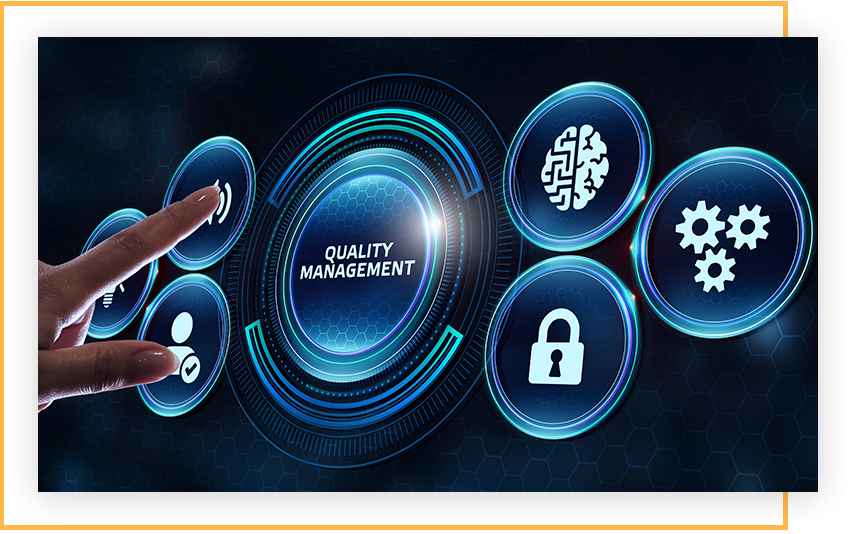Quality management is a critical aspect of any organization. It ensures consistency, compliance, and high standards in products and services.
But how can organizations ensure effective quality management? The answer lies in a Learning Management System (LMS).
An LMS is a powerful tool that can streamline quality assurance training. It can help maintain a robust quality management system across an organization.
In this article, we will explore why quality management demands an LMS. We will delve into how it can help achieve consistency and compliance, enhancing overall organizational performance.
The Role of LMS in Quality Management Systems
A Learning Management System (LMS) serves as a backbone in quality management systems. It offers a structured approach to managing and delivering quality assurance training.
Consistency is a hallmark of quality management. An LMS ensures uniformity in training across all levels of an organization. This consistency is crucial for maintaining high standards.
An LMS centralizes training materials and procedures, providing easy access for employees. This centralization facilitates seamless updates and ensures the latest information is readily available.
Moreover, an LMS supports diverse content types, enriching the learning experience. It can include videos, interactive modules, and documents to cater to different learning preferences.
Key roles of an LMS in quality management include:
- Streamlining training delivery and management
- Ensuring compliance with regulations
- Facilitating performance tracking and reporting
- Enhancing onboarding and continuous learning
Thus, an LMS not only supports but also elevates the entire quality management system.
Key Benefits of Integrating LMS with Quality Management
Integrating a Learning Management System with quality management offers multiple benefits. It equips organizations with tools to enhance efficiency.
First, an LMS ensures uniformity in training delivery. This uniformity minimizes discrepancies in knowledge across different departments.
Second, it optimizes compliance processes by automating documentation and reporting. Organizations can maintain regulatory adherence with ease.
Third, the centralized platform simplifies accessing training resources, ensuring everyone is on the same page.
Moreover, an LMS can cater to diverse content formats. This diversity enhances learner engagement and retention.
Additionally, the system facilitates continuous improvement through its robust analytics. These insights identify training gaps and areas for enhancement.
Here’s a concise list of key benefits:
- Ensures training uniformity
- Simplifies regulatory compliance
- Centralizes training materials
- Supports diverse content formats
- Enables continuous improvement
- Facilitates performance tracking
- Offers automated notifications
- Provides mobile accessibility
- Supports scalable training programs
- Enhances employee engagement
With these benefits, organizations can seamlessly integrate their quality management efforts with an LMS. It ensures that everyone involved maintains high standards.
Consistency in Training and Knowledge Dissemination
An LMS fosters consistency in training processes. It provides standardized content to all employees. This uniformity ensures everyone receives the same level of information.
The system eliminates variations in training delivery. It ensures that all team members have access to accurate and current resources. Consistency bolsters confidence in company processes.
Moreover, an LMS updates content seamlessly. These updates ensure that everyone stays informed about the latest protocols. This up-to-date knowledge is critical for maintaining standards.
Streamlined Compliance and Regulatory Adherence
Compliance often demands rigorous documentation. An LMS simplifies this process by automating record-keeping. This automation reduces manual errors and saves time.
By structuring training around regulatory needs, an LMS ensures alignment with industry standards. This alignment minimizes the risk of compliance breaches.
Additionally, it provides reminders for upcoming training and certification renewals. These notifications help organizations remain proactive in maintaining compliance.
Overall, the streamlined approach provided by an LMS reduces the risk of penalties. It also supports regulatory adherence through efficient management.
Centralization and Accessibility of Training Materials
Centralizing training materials within an LMS ensures easy access for everyone. Employees can retrieve needed documents swiftly. This ease of access encourages self-paced learning.
An LMS removes geographical barriers to training. Employees anywhere in the world can engage with content seamlessly. This global reach is crucial for multinational companies.
Having a single repository simplifies updates to training materials. Updates reach everyone simultaneously, maintaining uniformity and reducing discrepancies.
Lastly, centralization encourages a collaborative learning environment. Teams can share insights and strategies efficiently, fostering a culture of continuous improvement.
How Quality Assurance Training is Enhanced by an LMS
A Learning Management System (LMS) transforms quality assurance training by making it dynamic and responsive. It aligns training programs with specific organizational goals, ensuring relevance.
Tailored training content empowers employees with precise knowledge for their roles. Consequently, this boosts confidence and competency across the board.
An LMS also promotes engagement through varied content types. These formats include videos and interactive modules, which cater to different learning styles.
Automated features further enhance training efficiency. Reminders and notifications ensure timely participation, reducing oversight and non-compliance risk.
Furthermore, centralized data storage ensures training materials are up-to-date and accessible. This uniform access means that all employees learn from consistent resources.
In summary, an LMS bridges gaps in training delivery, creating a streamlined and effective learning environment. Organizations can realize improved operational outcomes with these advanced capabilities.
Customization and Role-Based Training
Customization is a hallmark of effective LMS-driven training. It allows organizations to create role-specific learning paths. These tailored modules match employees’ responsibilities.
An LMS fosters personalization to enhance relevance. Employees receive targeted content that aligns with their job functions and goals. This relevancy ensures employees gain applicable skills.
Role-based training eliminates unnecessary information. It sharpens focus on what truly matters, thus optimizing the learning experience. This targeted approach leads to better performance outcomes.
Tracking, Reporting, and Analytics for Continuous Improvement
With an LMS, tracking and reporting become straightforward and efficient. Organizations can monitor training progress with ease. Automated reports highlight completion rates and areas needing attention.
Analytics tools provide valuable insights into training effectiveness. They help identify skills gaps and opportunities for growth. Organizations can use this data to refine training programs.
The LMS’s analytics support continuous improvement by highlighting performance trends. These trends inform decision-making for future learning strategies.
Ultimately, tracking and reporting within an LMS enable a proactive approach. Organizations can adapt quickly to changing needs, ensuring ongoing excellence.
Achieving Compliance with Industry Standards through an LMS
Compliance with industry standards is essential for business operations. An LMS aids in meeting these standards by providing structured training modules.
These modules ensure employees understand regulations relevant to their work. Consequently, they adhere to necessary guidelines effectively.
An LMS also maintains comprehensive records of completed training. These records serve as evidence of compliance during audits and reviews.
Moreover, an LMS ensures consistency in knowledge dissemination. It supports organizations in achieving and maintaining compliance with ease.
ISO Standards and Audit Readiness
ISO standards are benchmarks for quality and safety across sectors. An LMS helps organizations align with these standards seamlessly.
With structured content, employees understand their roles in maintaining quality. They are better prepared for audits due to well-documented training records.
An LMS promotes audit readiness by ensuring necessary training is tracked. This preparation minimizes the risk of non-compliance during evaluations.
Certification Management and Risk Reduction
Managing certifications is simplified with an LMS. It tracks employee qualifications, ensuring certifications remain current.
Timely notifications remind staff of upcoming renewals, reducing lapses. This proactive management prevents any potential compliance issues.
Moreover, an LMS minimizes risk by ensuring competency through continuous training. It helps prevent errors that could jeopardize compliance or safety.
LMS Features That Support Quality Management
An LMS boasts a variety of features that enhance quality management. These features align with the demands of modern organizations aiming for excellence.
Key functionalities include:
- Interactive modules that engage learners
- Real-world simulations for practical experience
- Mobile access for learning flexibility
Additionally, these features ensure that training is not just effective but also adaptable to diverse needs. Real-time analytics help in pinpointing areas needing attention and adjustment. Thus, they support ongoing improvements in quality management processes.
Interactive Content and Real-World Simulations
An LMS provides interactive content that captivates and educates simultaneously. By incorporating real-world simulations, learners experience practical scenarios.
This method deepens their understanding of complex concepts. Employees can apply what they’ve learned in a controlled, risk-free environment.
Such immersive experiences boost confidence and competence, leading to better quality outcomes.
Mobile Accessibility and Flexible Learning
Mobile access is a standout feature of modern LMS platforms. Employees can complete training on-the-go, enhancing flexibility.
This ensures that learning fits seamlessly into their schedules. It eliminates barriers to knowledge acquisition, promoting consistent skill upgrades.
Flexible learning empowers workers to pursue education at their convenience, fostering a culture of continuous improvement.
Conclusion: The Strategic Advantage of a Quality Management LMS
A quality management LMS presents significant strategic benefits for organizations. It fosters consistency in training across all levels.
This uniformity ensures all employees receive the same high-quality learning experience. As a result, it improves both process reliability and compliance adherence.
Moreover, the LMS’s adaptability to various learning needs and schedules boosts employee engagement. This flexibility strengthens the culture of learning and improvement.
Ultimately, implementing a quality management LMS enhances organizational performance. It secures a competitive edge by ensuring that quality standards are consistently met and maintained.







